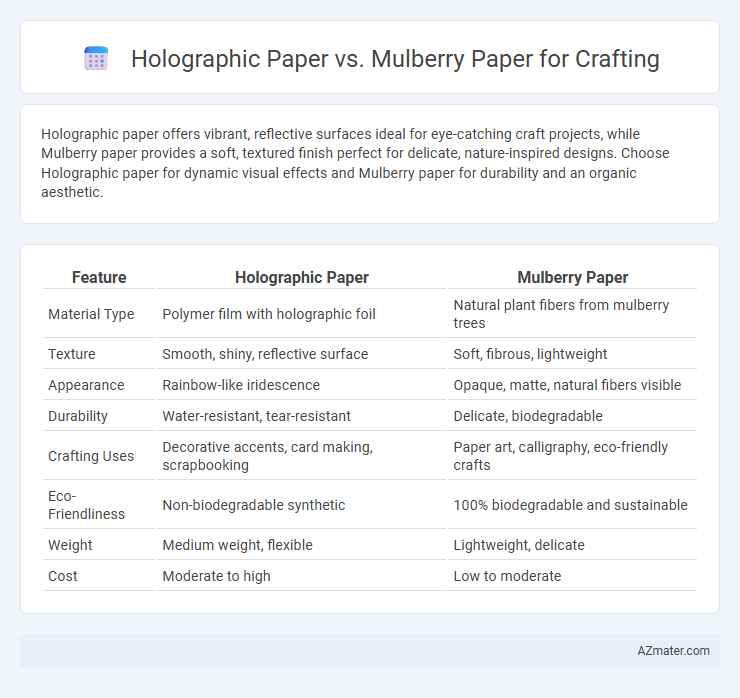Holographic paper offers vibrant, reflective surfaces ideal for eye-catching craft projects, while Mulberry paper provides a soft, textured finish perfect for delicate, nature-inspired designs. Choose Holographic paper for dynamic visual effects and Mulberry paper for durability and an organic aesthetic.
Table of Comparison
| Feature | Holographic Paper | Mulberry Paper |
|---|---|---|
| Material Type | Polymer film with holographic foil | Natural plant fibers from mulberry trees |
| Texture | Smooth, shiny, reflective surface | Soft, fibrous, lightweight |
| Appearance | Rainbow-like iridescence | Opaque, matte, natural fibers visible |
| Durability | Water-resistant, tear-resistant | Delicate, biodegradable |
| Crafting Uses | Decorative accents, card making, scrapbooking | Paper art, calligraphy, eco-friendly crafts |
| Eco-Friendliness | Non-biodegradable synthetic | 100% biodegradable and sustainable |
| Weight | Medium weight, flexible | Lightweight, delicate |
| Cost | Moderate to high | Low to moderate |
Introduction to Holographic and Mulberry Papers
Holographic paper features a reflective, prism-like surface that creates vibrant light patterns, making it ideal for eye-catching crafting projects and decorative accents. Mulberry paper, made from natural mulberry tree fibers, offers a delicate, fibrous texture prized for its durability and organic aesthetic, commonly used in handmade cards, scrapbooking, and fine art. Both papers provide unique tactile and visual qualities, catering to different creative needs in papercraft and mixed media artworks.
Key Characteristics of Holographic Paper
Holographic paper features a reflective, prism-like surface that creates a vibrant, shifting spectrum of colors, making it ideal for eye-catching craft projects. Its smooth texture contrasts with the fibrous, natural feel of mulberry paper, which is prized for its durability and organic appearance. The key characteristics of holographic paper include its high-gloss finish, light-weight flexibility, and ability to enhance visual appeal through dynamic color effects.
Unique Attributes of Mulberry Paper
Mulberry paper, crafted from the strong fibers of the mulberry tree, offers exceptional durability and a natural, textured surface ideal for intricate paper crafting and mixed media projects. Unlike holographic paper, which emphasizes reflective, shiny aesthetics, mulberry paper is biodegradable and highly absorbent, making it perfect for eco-friendly crafts and applications involving ink or dye. Its flexible yet sturdy fibers enable easy folding, layering, and embossing, enhancing tactile and visual appeal in handmade cards, scrapbooks, and decorative art.
Visual Appeal: Sparkle vs. Subtle Texture
Holographic paper offers a vibrant visual appeal with its dynamic sparkle and reflective surface, making it ideal for crafts that require attention-grabbing elements. Mulberry paper, by contrast, boasts a subtle texture with natural fibers, providing an elegant and organic aesthetic perfect for delicate, artisanal projects. Choosing between the two depends on whether the craft demands bold shimmer or understated sophistication in its visual presentation.
Durability and Strength Comparison
Holographic paper offers moderate durability with a smooth, reflective surface but tends to be more prone to tearing and bending under stress compared to mulberry paper. Mulberry paper, made from long fibers of the mulberry tree, provides superior strength and flexibility, making it ideal for intricate crafting projects that require resilience and longevity. The fibrous texture of mulberry paper enhances tear resistance and allows it to withstand various crafting techniques better than holographic paper, which is more decorative but less robust.
Suitability for Various Craft Techniques
Holographic paper excels in projects requiring vibrant, reflective surfaces and is ideal for card making, scrapbooking, and decorative accents that benefit from eye-catching shine. Mulberry paper, known for its fibrous texture and durability, suits techniques like decoupage, paper mache, and mixed media art where flexibility and strength are essential. Craft enthusiasts choose holographic paper for visual impact and mulberry paper for tactile, textured effects across diverse crafting styles.
Adhesion and Compatibility with Craft Supplies
Holographic paper offers excellent adhesion with standard craft glues and is highly compatible with adhesives like double-sided tape and spray adhesive, making it ideal for reflective, decorative projects. Mulberry paper, known for its fibrous texture and durability, allows for strong bonding with PVA glue and gel medium, ensuring secure attachment to various surfaces while enhancing tactile appeal. Both papers support different crafting techniques, but holographic paper excels in smooth, glossy finishes, whereas mulberry paper provides flexibility and strength in mixed-media applications.
Eco-Friendliness and Sourcing Considerations
Holographic paper is typically made from plastic-based materials, making it less eco-friendly due to limited recyclability and higher environmental impact during production compared to mulberry paper, which is derived from the bark of mulberry trees and is biodegradable and sustainably harvested. Mulberry paper supports eco-conscious crafting with its renewable sourcing, often produced using traditional, chemical-free methods that reduce pollution. When prioritizing sustainability, choosing mulberry paper aligns better with green practices and ethical sourcing considerations in the crafting industry.
Cost Analysis: Price vs. Value
Holographic paper typically costs more than mulberry paper due to its reflective, eye-catching surface that adds a premium look to craft projects. Mulberry paper offers greater value for cost-conscious crafters, as it is lightweight, durable, and works well with ink and paint, making it versatile for various artistic techniques. When comparing price versus value, holographic paper is ideal for projects prioritizing visual impact, while mulberry paper excels in affordability and functional quality.
Choosing the Right Paper for Your Craft Project
Holographic paper offers a shiny, reflective surface ideal for eye-catching decorations, while mulberry paper provides a textured, fibrous quality perfect for delicate, handmade crafts requiring durability and a natural look. Selecting the right paper depends on the desired visual effect and project purpose: holographic paper excels in vibrant, modern designs, whereas mulberry paper suits traditional, eco-friendly, or layered paper crafting techniques. Consider factors like flexibility, thickness, and color intensity to ensure optimal results for scrapbooking, card making, or decorative art pieces.

Infographic: Holographic paper vs Mulberry paper for Crafting
 azmater.com
azmater.com